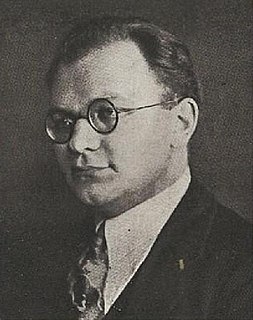Related Research Articles

Ludwig van Beethoven composed his Violin Concerto in D major, Op. 61, in 1806. Its first performance by Franz Clement was unsuccessful and for some decades the work languished in obscurity, until revived in 1844 by the then 12-year-old violinist Joseph Joachim with the orchestra of the London Philharmonic Society conducted by Felix Mendelssohn. Since then it has become one of the best-known violin concertos.

Walter Hamor Piston Jr,, was an American composer of classical music, music theorist, and professor of music at Harvard University.
Hans Graf is an Austrian conductor.

Jaroslav Řídký was a Czech composer, conductor, harpist, and music teacher.
Capricorn Concerto, Op. 21, is a composition for flute, oboe, trumpet and strings by Samuel Barber, completed on September 8, 1944. A typical performance lasts approximately 14 minutes.
David Van Vactor was an American composer of contemporary classical music.
Zdeněk Lukáš was a prolific Czech composer who composed over 330 works. He graduated from a teachers' college and worked as a teacher from 1953 to 1963. He was a musical editor and program director at the National Broadcasting Company in Pilsen and conducted the Česká píseň, a choir in Pilsen.
The Symphony No. 2, by Walter Piston is a symphony composed in 1943.
The Symphony No. 4 by Walter Piston is a symphony dating from 1950.
The Symphony No. 6 by Walter Piston was completed in 1955.
The Symphony No. 5 by Walter Piston was composed in 1954.
The Symphony No. 7 by Walter Piston is a symphony dating from 1960.
The Symphony No. 8 by Walter Piston is a symphony dating from 1965.
Three New England Sketches by Walter Piston is a symphonic suite dating from 1959.
Walter Piston's Capriccio for Harp and String Orchestra, was commissioned in 1963 by Broadcast Music Incorporated on the occasion of its twentieth anniversary, and is dedicated to the harpist Nicanor Zabaleta, who premiered it in Madrid on October 19, 1964.
A harp concerto is a type of musical composition composed for a solo harp player accompanied by a large ensemble, such as a concert band or orchestra.
A concert piece is a musical composition, in most cases in one movement, intended for performance in a concert. Usually it is written for one or more virtuoso instrumental soloists and orchestral or piano accompaniment.
References
- Pollack, Howard (1982). Walter Piston. Studies in Musicology. Ann Arbor MI: UMI Research Press. ISBN 9780835712804.
- Powell, Mel. 1960. "Walter Piston: Serenata for Orchestra, 1956; Bo Nilsson: Mädchentotenlieder; Roman Haubenstock-Ramati: Ständchen, sur le nom de Heinrich Strobel; Claude Ballif: Fantasie, Op. 21; Claude Ballif: Voyage de mon oreille, Op. 20; Yannis Xenakis: Achorripsis, für Orchester; Giselher Klebe: Konzert für Violoncello und Orchester, Op. 29; Ingvar Lidholm: Ritornello per orchestra; Hans Werner Henze: Drei Dithyramben, für Kammerorchester". Notes , Second Series, Vol. 17, No. 2 (March): 318–21.
Footnotes
- 1 2 Powell 1960, p. 319.
- ↑ Pollack 1982, p. 121.
- ↑ Pollack 1982, p. 122.